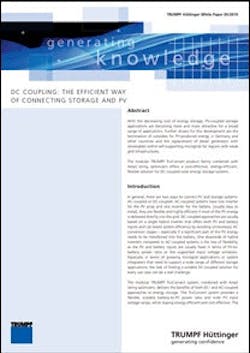With the decreasing cost of energy storage, PV-coupled storage applications are becoming more and more attractive for a broad range of applications. Further drivers for this development are the termination of subsidies for PV-produced energy in Germany and other countries and the replacement of diesel generators with renewables within self-supporting microgrids for regions with weak grid infrastructures.
The modular TRUMPF TruConvert product family combined with Ampt string optimizers offers a cost-effective, energy-efficient, flexible solution for DC-coupled solar energy storage systems.
In general, there are two ways to connect PV and storage systems: AC-coupled or DC-coupled. AC-coupled systems have one inverter for the PV array and one inverter for the battery. Usually easy to install, they are flexible and highly efficient if most of the PV energy is delivered directly into the grid. DC-coupled approaches are usually based on a single hybrid inverter that offers both PV and battery inputs and can boost system efficiency by avoiding unnecessary AC conversion stages – especially if a significant part of the PV energy needs to be transferred into the battery. One downside of hybrid inverters compared to AC-coupled systems is the loss of flexibility,
as the PV and battery inputs are usually fixed in terms of PV-to battery power ratio or the supported input voltage windows. Especially in terms of growing microgrid applications or system integrators that need to support a wide range of different storage applications, the task of finding a suitable DC-coupled solution for
every use case can be a real challenge.
